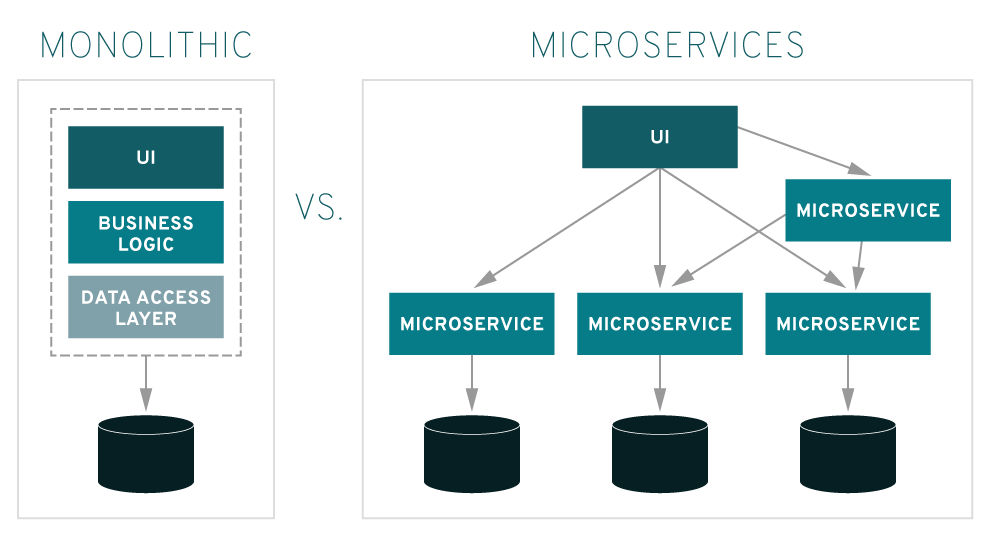Want to be fast? Want to be agile? At Microservices Day in NYC, Red Hat Director of Development Experience Burr Sutter discussed the path to success by using DevOps, self-service elastic infrastructure, automation, CI/CD, advanced deployment techniques, and microservices to cut wait times to new resources and functionalities from weeks to seconds.
As a major advocate for microservices and their place in incremental modernization strategy, Vizuri found this talk to contain an excellent explanation of the case for modern software architectures. This article contains a summary of the main points made for microservices and the Vizuri perspective on using them as the foundation for modernization.
Microservices needs DevOps and DevOps need microservices
It is easy to think of an application as the sum of its parts. But now, in the pursuit of agility, the parts become greater than the whole. When the application is conceptualized as a set of modules, or microservices, they can be distributed within a network of services.
Agility is based in continuous delivery, deployment, and improvement. Smaller deployments of these distributed microservices is one part of the solution. But to make this flexible and efficient microservices infrastructure work best, organizations need an equally efficient approach to execute the frequent deployments it enables. Enter DevOps.
In terms of process, a microservices architecture requires a DevOps approach for faster, more frequent deployments that fix issues, introduce new features, and improve security at the speed of user expectations. In turn, microservices facilitate DevOps by decoupling previously tightly coupled application services so that updates to one won’t break the whole.
Dividing a monolithic application into microservices also allows fixes and changes to occur at the service level, making for smaller, more frequent deployments that result in flexibility and the increased agility that organizations want.
The widespread success of microservices adoption has created complexities in application management across distributed environments, which Kubernetes/OpenShift ably helps to address.
Sutter explains in his talk how many organizations escape their monolithic applications in favor of microservices in an incremental manner. Individual microservices are built and deployed to OpenShift alongside existing application functions.
This approach provides the ability to retire those functions over time and lowers risks associated with holistic, dramatic architectural change. Gradually, organizations refactor their applications and entirely replace them with discrete, loosely coupled microservices.
Microservices let organizations incrementally move on from legacy
Vizuri is a big proponent of incremental modernization. Not only does this approach help to avoid risks and downtime associated with huge overhauls, but it also helps organizations nurture the practices and workflows needed to run modern information architectures that produce agility.
As Sutter recommended in his talk, microservices can gradually replace parts of an original rigid monolithic application. At the end of this process, these pieces can be deployed in a scalable cloud or hybrid environment, dissipating the strain that Vizuri has seen organizations experiencing as they transition from legacy systems to modern cloud-based services.
A microservices design also improves the quality of the software by promoting reusability and composability while improving the maintainability of the code.
Invest in knowledge management to make microservices meaningful
Implementing microservices aggregates knowledge into discernible and discrete functions to be performed. The single-purpose microservice design provides a platform allowing organizations to develop, run, and manage business functionalities without the complexity of building and maintaining an entire application that consumes this complete knowledge.
To back track for a moment, what is the meaning of “knowledge?” Applications are built with knowledge and business requirements baked into them. For example, a certain business may want their application to send a prompt to a designated approval group when a pending transaction requires their approval. To create this application function, business knowledge and rules have to be incorporated into the development of the application so that it knows how and when to direct prompts.
For this reason, the path toward creating application services that do what business needs require of them can be fraught with additional complications. This is why Vizuri also promotes knowledge management as part of the basis for modernization—it provides meaning and function to a microservices architecture in a structured way.
Read more about this important element of digital transformation in our free e-book:
Also watch Vizuri SVP Joe Dickman’s talk, Extend Existing Investments in Microservices to Leverage AI & Machine Learning, also from Microservices Day in NYC, to start putting together how knowledge and microservices can help take advantage of AI and machine learning. To start the transition to microservices or in using AI and machine learning to gain agility, organizations should assess their approach to knowledge management and definition of business rules.
The path to microservices is synonymous with the path to agility. Not sure where to start? Reach out any time to get help.





